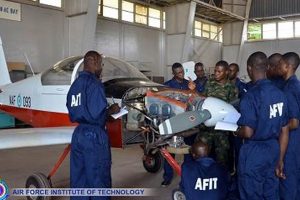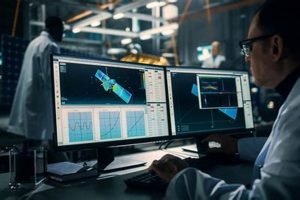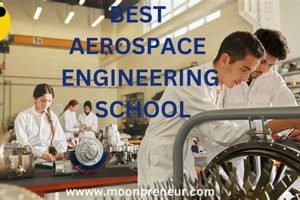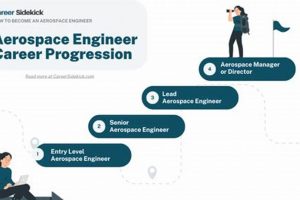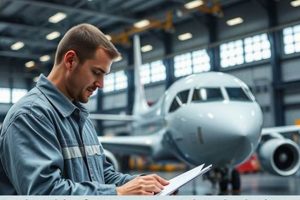Professionals in this field apply scientific and engineering principles to design, develop, test, and evaluate aircraft and spacecraft. Their work encompasses a wide range of activities, from conceptualizing new vehicle designs to improving the performance and safety of existing systems. For example, these individuals might work on developing more fuel-efficient aircraft wings or designing the propulsion systems for interplanetary probes.
Contributions from individuals in this area are vital to advancing both aviation and space exploration. Their efforts lead to safer air travel, more efficient transportation systems, and groundbreaking scientific discoveries in space. Historically, their innovations have driven economic growth, strengthened national security, and expanded human understanding of the universe. The pursuit of knowledge and technological advancement in these areas has always been a key driver of progress.
This exploration continues with an in-depth examination of the core skills required for success in this discipline, the typical educational pathways to enter the profession, and the evolving challenges and opportunities that await those who choose to pursue it. Subsequent sections will further detail specific areas of specialization within the broader domain, including computational fluid dynamics, structural analysis, and control systems design.
Essential Guidance for Aspiring Professionals
The following provides actionable advice derived from the experience and expertise of seasoned professionals in the aerospace field. Adherence to these principles can significantly enhance career prospects and contribute to professional success.
Tip 1: Emphasize Strong Foundational Knowledge: A solid understanding of mathematics, physics, and fundamental engineering principles is paramount. These form the bedrock upon which advanced aerospace concepts are built.
Tip 2: Cultivate Proficiency in Computational Tools: Familiarity with software packages used for design, analysis, and simulation is crucial. Examples include MATLAB, ANSYS, and computational fluid dynamics (CFD) software.
Tip 3: Seek Opportunities for Hands-on Experience: Internships, research projects, and participation in engineering competitions provide invaluable practical experience and enhance understanding of real-world applications.
Tip 4: Develop Effective Communication Skills: The ability to clearly and concisely communicate technical information, both orally and in writing, is essential for collaboration and dissemination of research findings.
Tip 5: Stay Abreast of Technological Advancements: The aerospace sector is characterized by rapid innovation. Continuous learning and adaptation to emerging technologies are vital for sustained professional growth.
Tip 6: Prioritize Collaboration and Teamwork: Aerospace projects are typically complex and require the coordinated efforts of multidisciplinary teams. Developing strong collaborative skills is essential.
Tip 7: Consider Advanced Education: A master’s degree or doctorate can significantly enhance career prospects, particularly for those seeking roles involving research and development.
These guidelines represent a distillation of key attributes and practices that contribute to success. By embracing these principles, individuals can position themselves for a rewarding and impactful career.
The subsequent sections will delve into specific career paths and opportunities within the broader aerospace engineering landscape, providing a more nuanced understanding of the diverse roles available.
1. Innovation
The role of an aerospace research engineer is intrinsically linked to innovation. It is the driving force behind advancements in aircraft design, propulsion systems, materials science, and space exploration. The demand for improved performance, increased safety, and reduced environmental impact necessitates a constant pursuit of novel solutions. These professionals are tasked with conceiving, developing, and implementing groundbreaking technologies that push the boundaries of what is currently achievable. For instance, the development of composite materials for aircraft structures, enabling lighter and more fuel-efficient designs, is a direct result of innovation driven by such engineers.
Innovation is not simply invention, but a process of translating novel ideas into tangible improvements. Aerospace research engineers apply scientific principles and engineering methodologies to refine concepts, address technical challenges, and ensure practical feasibility. This often involves extensive modeling, simulation, and experimentation. The development of scramjet engines, which promise hypersonic flight capabilities, provides another illustration. These advanced engines require innovative approaches to fuel injection, combustion control, and thermal management, all areas where these professionals play a pivotal role.
Ultimately, the ability to foster and implement innovation is critical for maintaining competitiveness in the aerospace industry and achieving ambitious goals in space exploration. By focusing on continuous improvement and embracing new technologies, aerospace research engineers contribute significantly to technological advancements. This allows them to solve problems, creating tangible benefits across a wide spectrum of applications. The work they produce ensures that the future of aerospace remains one of continuous progress and groundbreaking achievements.
2. Analysis
Analysis forms a cornerstone of the work performed by professionals in aerospace research. It provides the rigorous framework needed to understand complex phenomena, evaluate design proposals, and optimize performance characteristics. It is through meticulous analysis that theoretical concepts are translated into practical and reliable systems.
- Computational Fluid Dynamics (CFD) Analysis
CFD analysis allows for the simulation of airflow around aircraft and spacecraft, enabling engineers to predict aerodynamic forces, optimize shapes for reduced drag, and assess thermal behavior. For example, CFD is used extensively in the design of wing profiles for commercial airliners to maximize lift and minimize fuel consumption. The insights from CFD directly inform design decisions and validate performance predictions, ensuring the safety and efficiency of flight.
- Structural Analysis
Structural analysis assesses the integrity of aerospace components under various loading conditions. Techniques like Finite Element Analysis (FEA) are used to model stress and strain distributions within structures, ensuring they can withstand the forces encountered during flight or space travel. Accurate structural analysis is critical in preventing catastrophic failures and ensuring the long-term reliability of aircraft and spacecraft. For instance, it is employed to verify the structural integrity of rocket nozzles under extreme thermal and pressure loads.
- Data Analysis and Statistical Modeling
Aerospace research generates vast amounts of data from experiments and simulations. Data analysis techniques, including statistical modeling, are used to extract meaningful insights from this data, identify trends, and validate theoretical models. For example, flight test data is analyzed to assess the performance of new aircraft designs and identify areas for improvement. Statistical models can be used to predict component lifespans and optimize maintenance schedules, enhancing safety and reducing operational costs.
- Systems Analysis
Systems analysis involves evaluating the interactions between different components and subsystems within an aerospace vehicle. This holistic approach is crucial for understanding how changes in one area can affect the overall performance and reliability of the entire system. For example, systems analysis is used to optimize the integration of propulsion, avionics, and control systems in an aircraft, ensuring that they work together seamlessly to achieve desired flight characteristics.
These diverse forms of analysis are indispensable tools in the hands of these engineers. Through their effective application, designs are optimized, risks are mitigated, and the performance and safety of flight are continuously improved. By understanding underlying complex systems, this group of professionals push advancements in air and space travel.
3. Design
Design is inextricably linked to the role. These individuals don’t merely analyze existing systems; they create new ones and improve upon the current state of the art. Design, in this context, is the process of translating abstract requirements and scientific principles into tangible hardware and software solutions capable of performing specific tasks within the aerospace environment. The cause-and-effect relationship is clear: identified needs and scientific breakthroughs drive the design process, while the effectiveness of the design directly impacts the performance and capabilities of aerospace systems. A failure in the design phase can lead to catastrophic consequences, underlining the critical importance of meticulousness and expertise. Consider, for example, the design of a new aircraft wing. This involves not only aerodynamic considerations but also structural integrity, weight optimization, and manufacturability, all of which must be carefully balanced to achieve the desired performance characteristics.
The design process within aerospace research is often iterative, involving cycles of modeling, simulation, prototyping, and testing. This cyclical approach allows for continuous refinement and optimization, ensuring that the final product meets stringent performance criteria and safety standards. The application of computer-aided design (CAD) and computer-aided engineering (CAE) tools is essential for creating detailed models, performing complex analyses, and simulating real-world operating conditions. For instance, these tools are used extensively in the design of spacecraft heat shields, which must withstand extreme temperatures and pressures during atmospheric re-entry. Similarly, they are employed in the development of advanced propulsion systems, such as rocket engines and scramjets, where efficient combustion and thrust generation are paramount.
In summary, design is not merely a component of the job title; it is a fundamental activity that defines the role. The ability to translate theoretical knowledge into practical and effective designs is essential for achieving advancements in aviation, space exploration, and related technologies. While the challenges are significant, the potential rewardssafer air travel, more efficient transportation, and groundbreaking scientific discoveriesmake the pursuit of excellence in design a critical endeavor. This process involves the culmination of several complex processes to deliver the optimized output that is required.
4. Testing
Testing is an indispensable element of the endeavors of this engineering role. It serves as the validation point, confirming theoretical predictions and design specifications. This phase involves subjecting aerospace components and systems to rigorous conditions, mimicking or exceeding those encountered during actual operation. The cause-and-effect relationship is direct: design decisions (cause) are evaluated through testing, leading to design refinement or acceptance (effect). Without comprehensive testing, the potential for catastrophic failure in flight or space is substantially increased, highlighting its practical significance.
Several distinct types of testing are prevalent. Wind tunnel testing is used extensively to assess the aerodynamic characteristics of aircraft and spacecraft designs. Structural testing evaluates the integrity of components under stress, vibration, and extreme temperatures. Propulsion system testing verifies the performance and reliability of engines under various operating conditions. Software testing validates the functionality and robustness of flight control systems. Consider the development of a new composite material for aircraft wings: extensive testing is required to determine its strength, fatigue resistance, and environmental durability before it can be implemented. This process involves both destructive and non-destructive testing methods, ensuring that the material meets stringent safety and performance standards. Testing helps to reduce risks associated to the engineering component.
Effective testing requires careful planning, execution, and data analysis. Engineers must define clear test objectives, select appropriate test methods, and establish acceptance criteria. Sophisticated instrumentation and data acquisition systems are used to monitor performance parameters and identify potential issues. The results of testing inform design modifications, material selection, and manufacturing processes, ultimately contributing to the development of safer, more efficient, and more reliable aerospace systems. In conclusion, testing is not merely a procedural formality; it is an integral part of the engineering life cycle, essential for ensuring the safety and success of aerospace endeavors.
5. Materials
The advancement of aerospace technology is inextricably linked to the development and application of advanced materials. These materials, carefully selected and engineered, dictate the performance, safety, and efficiency of aircraft and spacecraft. Professionals in this field are instrumental in researching, developing, and implementing these materials, directly influencing technological progress. For example, the transition from aluminum to composite materials in aircraft structures has enabled significant weight reduction, leading to improved fuel efficiency and performance. This shift was driven by a need for lighter, stronger materials and was realized through the efforts of engineers specializing in materials science within the aerospace sector. A direct relationship exists: the properties of the materials employed directly affect the capabilities and limitations of flight vehicles.
The selection of materials depends on the specific application and the operating environment. Aerospace vehicles endure extreme conditions, including high and low temperatures, intense pressure, and radiation exposure. For instance, materials used in spacecraft heat shields must withstand temperatures exceeding thousands of degrees Celsius during atmospheric re-entry. Engineers utilize advanced techniques to analyze the properties of different materials, including metals, ceramics, polymers, and composites, and assess their suitability for specific aerospace applications. They also develop new materials with tailored properties to meet the evolving demands of the aerospace industry. The design and fabrication of turbine blades for jet engines, which must withstand high temperatures and centrifugal forces, represent another critical application of materials science in aerospace.
In summary, the exploration and application of advanced materials are essential to the continued progress of aerospace engineering. These individuals play a pivotal role in identifying, developing, and implementing materials that enable lighter, stronger, more efficient, and safer aerospace systems. Challenges remain in the development of materials that can withstand ever-more-extreme environments and that are sustainable and cost-effective to produce. The continued focus on materials science is crucial for achieving future advancements in aviation and space exploration, ensuring increased performance and reliability. Therefore, the link between materials science and aerospace advancement is vital for aerospace engineering.
6. Collaboration
Within the landscape of aerospace research, professionals rarely operate in isolation. Collaboration is a fundamental aspect of their work, influencing project outcomes and driving innovation. The complexity of aerospace projects necessitates the integration of diverse skill sets and knowledge domains. Cause and effect are clearly demonstrated; the integration of expertise results in comprehensive solutions. For example, the development of a new aircraft requires collaboration between aerodynamicists, structural engineers, propulsion specialists, and avionics experts. The failure to effectively integrate these disciplines can lead to design flaws, performance limitations, or safety hazards. Therefore, teamwork is vital for optimal output.
The importance of collaboration extends beyond internal teams to include partnerships with external organizations. Aerospace research often involves collaborations with universities, government agencies, and industry partners. These partnerships facilitate the sharing of resources, expertise, and infrastructure, accelerating the pace of innovation. The development of the Space Shuttle, for instance, involved extensive collaboration between NASA, private aerospace companies, and research institutions. The success of the program depended on the effective coordination of these diverse entities. Sharing and coordinating efforts increases the pace of innovation which is key to developing new technologies.
Effective collaboration requires strong communication skills, mutual respect, and a shared understanding of project goals. These individuals must be capable of articulating their ideas clearly, listening attentively to others, and resolving conflicts constructively. Collaboration is not merely a procedural requirement; it is a critical element of the engineering process that fosters creativity, enhances problem-solving capabilities, and ultimately contributes to the success of aerospace endeavors. Therefore, professionals must be able to communicate their ideas to effectively share with others to achieve success.
Frequently Asked Questions
This section addresses common queries related to the work, required skills, and career paths available to those in the aerospace research engineering field. It aims to provide concise and informative answers to prevalent questions.
Question 1: What distinguishes aerospace research engineers from other engineering disciplines?
Aerospace research engineering focuses specifically on the design, development, and testing of aircraft, spacecraft, and related systems. It requires a specialized understanding of aerodynamics, propulsion, materials science, and other disciplines relevant to flight and space travel. Other engineering disciplines, such as mechanical or electrical engineering, have broader applications beyond the aerospace sector.
Question 2: What are the fundamental educational requirements to pursue this career path?
A bachelor’s degree in aerospace engineering or a closely related field is typically the minimum requirement. Advanced degrees, such as a master’s or doctorate, are often necessary for research-intensive roles. Coursework should include mathematics, physics, fluid mechanics, structural analysis, and control systems.
Question 3: What key skills are most valued in this profession?
Essential skills include a strong foundation in scientific principles, proficiency in computational tools, analytical and problem-solving abilities, effective communication skills, and the capacity for teamwork and collaboration. The ability to adapt to rapidly evolving technologies is also crucial.
Question 4: What are some typical job responsibilities encountered in this profession?
Job responsibilities may include designing and analyzing aircraft or spacecraft components, conducting experiments and simulations, developing new materials and propulsion systems, testing and evaluating prototypes, and preparing technical reports and presentations. These individuals collaborate with scientists and other engineers.
Question 5: How does one stay current with rapidly evolving technology within the aerospace field?
Continuous learning is essential. Staying current involves reading technical journals, attending conferences and workshops, participating in professional organizations, and engaging in ongoing training and development activities. A commitment to lifelong learning is vital.
Question 6: What are the primary career paths for professionals in this field?
Career paths include roles in research and development, design engineering, testing and evaluation, project management, and academia. Opportunities exist in government agencies, private aerospace companies, and research institutions.
In summary, success in the role requires a combination of specialized knowledge, technical skills, and a dedication to continuous learning. The field offers diverse and challenging career opportunities for those with a passion for aviation and space exploration.
The subsequent sections will delve into emerging trends and challenges within aerospace engineering, providing a forward-looking perspective on the future of the profession.
Conclusion
This exploration has provided an overview of the multifaceted role of an aerospace research engineer. Their work encompasses a broad spectrum of activities, from theoretical analysis and design to experimental testing and material development. The importance of collaboration, continuous learning, and adherence to rigorous scientific principles have been emphasized as crucial elements for success in this demanding field.
The challenges facing the aerospace industry, from developing sustainable aviation technologies to expanding human presence in space, necessitate continued innovation and expertise. The future of flight and space exploration depends on the dedication and ingenuity of these professionals. Further investigation and advancement in this sector are essential for pushing the boundaries of what is possible and ensuring continued progress in aerospace technology.


